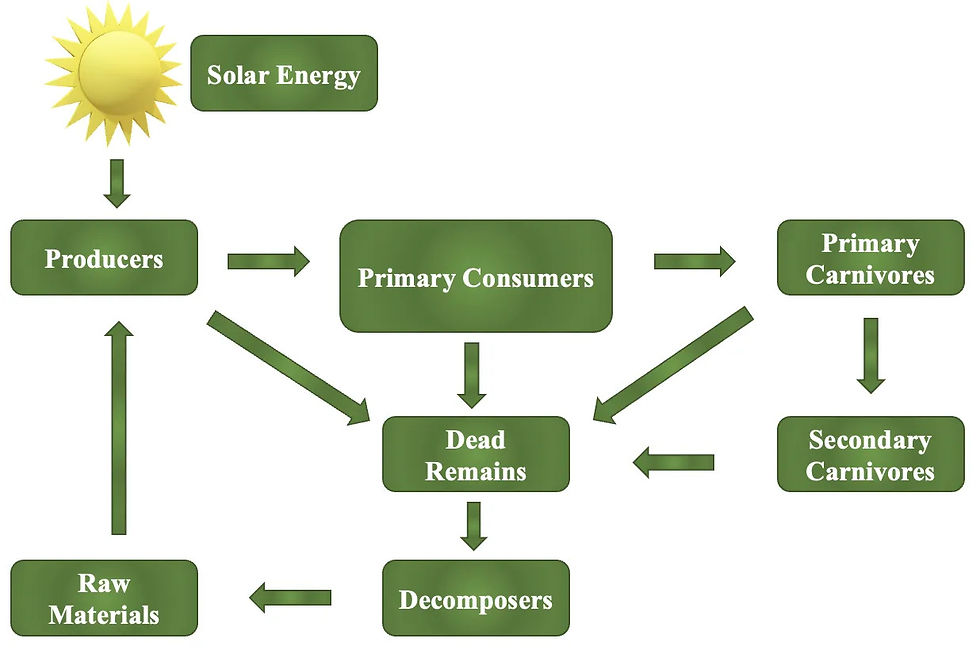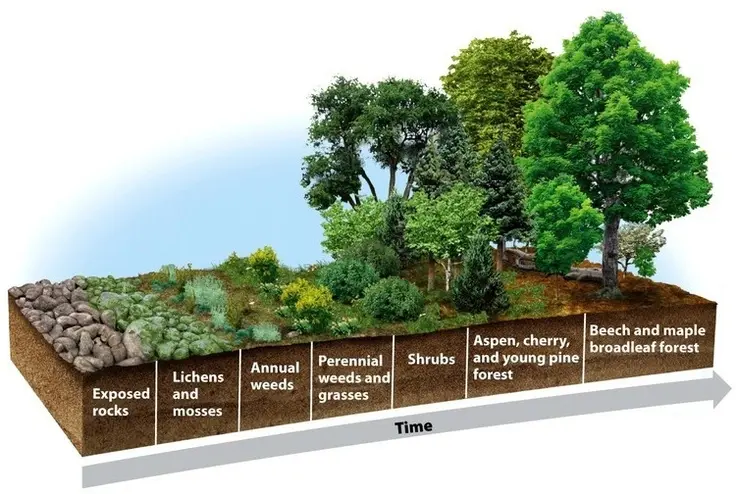Components of an Ecosystem
- Naveen Kumar
- Apr 6, 2024
- 3 min read
Updated: Apr 14, 2024
The ecosystem consists of both the living and the non-living components. Living organisms cannot live in isolation from their non-living environment. This is because the non-living environment provides materials and energy for the very survival of living organisms. The community with all the plants and animals forms the living or biotic component. The organic and inorganic substances together with climatic factors constitute the non-living or abiotic component of the ecosystem.

Biotic Component
These include the living components of the ecosystem that interact with the non-living components. They are categorized into (1) Producers, (2) Consumers, and (3) Decomposers. |
(1) Producers
They are also known as autotrophs or self-nourishing. Since they produce food for other organisms, they are known as producers.
They include organisms, which produce their food by fixing solar energy in the presence of abiotic substances. Producers mainly include green plants, algae, cyanobacteria, purple and green sulfur bacteria, etc.
(2) Consumers
They are also called heterotrophs or “Phagotrophs”. Consumers include those organisms that consume the food produced by the producers.
Consumers cannot produce their food. So they have to depend on other organisms for food and nutrition. They derive nutrition by feeding on other living organisms.
Types of Consumers
Primary Consumers – they are commonly called herbivores. They are animals that derive nutrition directly from consuming producers or green plants. E.g. insects, rabbits, cows, goats, etc. are some of the common herbivores in the terrestrial ecosystem. Small crustaceans, snails, fishes, etc. are herbivores in the aquatic ecosystem.
Secondary Consumers – They are commonly called carnivores. They are flesh-eating animals that get nutrition indirectly from producers by eating herbivores. The organisms that can feed on both plants and animals are called omnivores such as human beings, foxes, etc. Omnivores are both herbivores and carnivores. |
Tertiary Consumers – these are the top carnivores that prey upon carnivores, omnivores, and herbivores. Lions, tigers, sharks, eagles, etc. are considered tertiary consumers
(3) Decomposers
They are also known as “Saprotrophs”. They are micro-organisms mostly bacteria, fungi, protozoa, etc.
Instead of ingesting food as done by the heterotrophs, they release enzymes into the dead organic matter and then absorb some of the degraded product.
Decomposers attack the dead remains of producers and consumers and degrade the complex organic substances into simpler compounds. They utilize organic matter, derive energy, and release inorganic substances for recycling. These inorganic substances are reused by producers for the process of photosynthesis.
Recycling nutrients in the ecosystem through the mineralization of dead organic minerals is the most important role of decomposers.
Mineralization is the conversion of dead organic matter into simple forms of nutrients that producers can use again.
Apart from processing and removing organic wastes, decomposers regenerate ecosystem fertility by releasing nutrients that are locked up in the organic matter.

Abiotic Component
These non-living components affect the distribution, number, metabolism, and behavior of organisms in an ecosystem. Abiotic factors influence the presence of biotic components largely.
There are three broad categories of abiotic components in all ecosystems:-
Inorganic substances
Dead organic matter
Ecological factor
(1) Inorganic Substances
The different life processes of living organisms depend on various elements. Elements that are needed in large amounts are called macronutrients. Examples:- carbon, hydrogen, oxygen, nitrogen, potassium, calcium, sodium, magnesium, iron, phosphorus and sulfur.
Substances required in small amounts are called micronutrients. Examples:- Copper, Manganese, Selenium, Zinc, Molybdenum, Boron, Silicon etc.
Some of these micronutrients often serve as limiting factors affecting the growth, survival, and propagation of living organisms.
(2) Organic Substances
These are formed as a result of the degradation of various dead and decomposed bodies of organisms and excretory materials of different organisms. Decomposing organic matter releases nutrients into the soil.
These include carbohydrates, proteins, Lipids, and their derivatives.
It also forms a dark, soft spongy substance known as humus, which is important for soil fertility. Humus gets converted into mineral elements as a result of climatic factors and the action of microorganisms.
(3) Ecological Factors
Ecological factors are classified as
Climatic Factors – Light, temperature, wind velocity, atmospheric gases, rainfall, and atmospheric humidity.
Edaphic Factors – Soil-mineral matter, organic matter, soil water, and soil air
Topographic Factors – Altitude, steepness of slope, and direction of the slope.

Limiting Factors
Plants and animals all have a range of tolerance for certain environmental factors like light, soil, water, temperature, humidity, etc.
If an environmental factor essential for life is absent or is below or above the critical range for a particular species, the factor is called a limiting factor for that species.
An organism may have a wide tolerance range for one factor but a narrow range for another.
For example, freshwater fishes have a wide range of temperature tolerance but a narrow range of tolerance for salts; so they perish when the concentration of salts in water increases (i.e., in seawater).
Limiting factors are both biotic and abiotic.
They control the actual distribution and abundance of organisms in nature.



